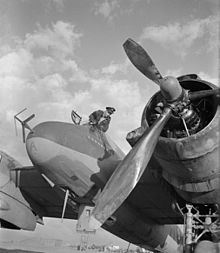Portal:Electronics/Selected article/26
Radar, Aircraft Interception, Mark IV (AI Mk. IV), also produced in the USA as SCR-540, was the world's first operational air-to-air radar system. Early Mk. III units appeared in July 1940 on converted Bristol Blenheim light bombers, while the definitive Mk. IV reached widespread availability on the Bristol Beaufighter heavy fighter by early 1941. On the Beaufighter, the Mk. IV arguably played a role in ending the Blitz, the Luftwaffe's night bombing campaign of late 1940 and early 1941.
Early development was prompted by a 1936 memo from Henry Tizard on the topic of night fighting. The memo was sent to Robert Watson-Watt, director of the radar research efforts, who agreed to allow physicist Edward George "Taffy" Bowen to form a team to study the problem of air interception. The team had a test bed system in flights later that year, but progress was delayed for four years by emergency relocations, three abandoned production designs and Bowen's increasingly adversarial relationship with Watt's replacement, Albert Rowe. Ultimately, Bowen was forced from the team just as the system was finally maturing. (Full article...)

